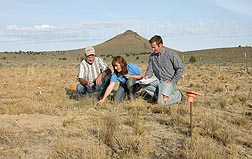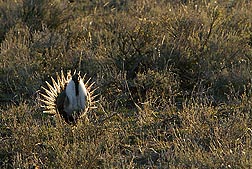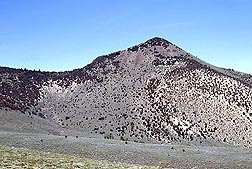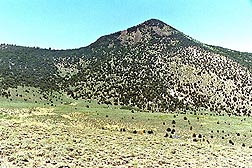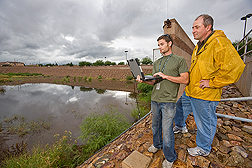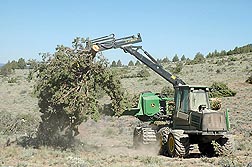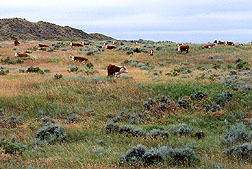Turning Trees Into Fuels
In western U.S. rangelands, native juniper and pinyon pine trees are spreading beyondtheir historical ecological niches and disrupting the environmental balance of their expanded range. Meanwhile, Agricultural Research Service scientists are teaming with university and industry colleagues to turn this problem into a source of fuel.
"Juniper competes with grass and forbs for water and nutrients, and this leaves bare soil that is vulnerable to erosion," says research leader Mark Weltz, who works at the ARS Great Basin Rangelands Research Unit in Reno, Nevada. "We have also lost habitat for sage grouse and mule deer, and the amount of forage available for cattle has declined as well."
"Our options for controlling juniper expansion are limited," adds ARS rangeland scientist Tony Svejcar, who is the research leader at the Eastern Oregon Agricultural Research Center in Burns, Oregon. "There's not much of a market for cut juniper, so we usually just cut the trees and leave them where they fall."
Pinyon pine trees, which in the western United States often grow alongside juniper, present similar management problems. The good news is that some preliminary estimates suggest that harvesting a percentage of these hardy trees every year could supply enough biomass to produce millions of gallons of fuel. Removing the trees would help restore productive rangeland for livestock and protect critical sagebrush habitat for threatened species such as the western sage grouse. The time is right to develop a comprehensive strategy for harvesting the trees and using the woody biomass to jumpstart a regional biofuel industry.
Taking Stock
The first step in the process is taking an inventory of how many trees could be harvested for use as biofuel feedstocks. Current remote-sensing work by ARS rangeland scientists-using satellite data to identify juniper and pinyon pine trees and estimate the density of mature trees-has given the process a head start. (See "Tools for Tracking Troublesome Trees" in this issue.)
|
|
"This will help us locate where trees can be harvested and figure out how many trees are actually available to use for biofuel development," says Svejcar. "We can also use this information to determine where wildlife habitat would be best restored and avoid harvesting in areas where it could harm existing wildlife populations."
The next task will be to devise plans for harvesting the trees in a sustainable manner, a process dictated in part by environmental characteristics that differ across the vast western rangelands. ARS scientists have already conducted considerable research that will help determine how harvesting the trees could affect the ecological health of this region.
For instance, ARS scientist Fred Pierson is using watershed data gathered over the past 50 years from the Reynolds Creek Experimental Watershed in Idaho to simulate how tree harvests would affect water runoff from the surrounding terrain. His previous work involved studying hillslope erosion processes across the Great Basin. Now he plans to conduct experimental juniper harvests on a variety of sites to observe how the removal affects soil erosion from snow runoff water. He'll use the information to model the environmental impacts of large-scale tree harvests.
|
|
Pierson will also be monitoring how juniper removal affects large-scale water cycles. "Junipers draw a great deal of water from the soil," says Pierson, research leader at the ARS Northwest Watershed Research Center in Boise, Idaho. "Up to this point, we've only looked at the water demand of individual trees. But now we're looking at how whole juniper forests affect water cycles in entire watersheds, which is important for calculating how much more water could be available after the trees are removed."
Pierson's preliminary findings suggest that invasive juniper stands have affected long-term patterns of snowpack formation and snowmelt schedules-two essential processes in the availability and delivery of irrigation water to farmers. Harvesting trees will allow him to observe any shifts in water supplies that result from clearing juniper trees from the landscape.
Models for Management
Much of the harvest planning will be conducted with computer models that have been developed by ARS scientists and their colleagues. One of these models, the Rangeland Hydrology and Erosion Model (RHEM), was developed in 2009 and produces estimates for storm-water runoff and soil erosion for hillslopes. Another ARS program, called "KINEROS2," incorporates RHEM to provide estimates of watershed-level rainfall runoff and erosion as well.
The newest modeling program is the Automated Geospatial Watershed Assessment tool, known as "AGWA." It fine-tunes watershed delineations by incorporating layers of GIS data, such as soils and land-cover data, into KINEROS2 watershed models. David Goodrich, a hydraulic engineer at the ARS Southwest Watershed Research Center in Tucson, Arizona, will work with the team to improve modeling estimates of watershed-level rainfall runoff and erosion, which will help guide decisions on where to harvest trees.
Stringham and Keirith Snyder, an ARS scientist with the Reno unit, will also design site-restoration plans so landowners and those who utilize the biomass can ensure that the harvests are conducted sustainably from beginning to end. One of the tools that can help with this process is an ARS decisionmaking model called "Ecologically Based Invasive-Plant Management" (EBIPM), which can be used to develop plans for restoring native plants on terrain previously overrun by invasive vegetation. (See "Step-by-Step Strategies for Restoring Western Rangelands," Agricultural Research, February 2012.)
In addition, using state-and-transition model mapping techniques to obtain information about soils and other site characteristics that affect restoration plans could make EBIPM assessments even more effective. (See "Better Maps Mean Better Rangeland Management" in this issue.) Carefully integrating plans that include tree inventory, harvest, and site-restoration methods will be essential to ensuring that an emergent biofuel industry leaves the landscape in better shape than before.
"The federal government is already spending millions of dollars every year to remove these trees," says Weltz, who will be assisting in some of the modeling work. "Development of a biofuel industry would add new job opportunities in rural areas that need new businesses. It could be a win-win-win for everyone."—By Ann Perry, Agricultural Research Service Information Staff.
This research is part of Pasture, Forage, and Rangeland Systems (#215) and Water Availability and Watershed Management (#211), two ARS national programs described at www.nps.ars.usda.gov.
To reach scientists mentioned in this article, contact Ann Perry, USDA-ARS Information Staff, 5601 Sunnyside Ave., Beltsville, MD 20705-5128; (301) 504-1628.
The ARS Network of Biomass Centers
The Agricultural Research Service locations included in this story are parts of the U.S. Department of Agriculture's Western and Northwestern Regional
Biomass Research Centers network. The network is made up of five national centers whose mission is to help accelerate the establishment and production of sustainable commercial biomass from farms and forests without disrupting the production and marketing of food, feed, and fiber.
"Turning Trees Into Fuels" was published in the July 2013 issue of Agricultural Research magazine.







